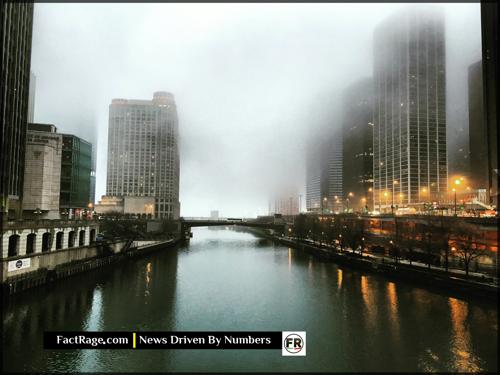CHICAGO, IL – The receding waters from last week’s historic downpour have revealed a starkly divided city, where the impact of the flood was determined less by the volume of rain and more by decades-old infrastructure and policy decisions.
- Disproportionate Impact – Neighborhoods on the city’s South and West Sides, including Austin, Chatham, and South Deering, experienced severe basement flooding and property damage, while more affluent North Side areas saw significantly less impact.
- Aging Infrastructure – Much of Chicago relies on a 100-year-old combined sewer system that mixes stormwater and raw sewage, which is easily overwhelmed by intense rain events, causing backups into homes and waterways.
- Historical Roots – Current flood-prone areas strongly correlate with historically redlined and disinvested communities, which received less public funding for infrastructure upgrades and green space development over many decades.
For residents in some parts of Chicago, cleaning out a flooded basement has become a grim, recurring ritual. While the storm was citywide, the crisis was not. Understanding why requires looking deeper than the storm drains and further back than the last weather report.
The Map Beneath the Water
![]() When a storm hits a major city, the headlines focus on the weather. But the real story is often found street by street, in the pipes and plans that were laid decades ago. In Chicago, as in so many American places, the infrastructure beneath the ground tells a story of priorities, promises kept, and promises broken. Understanding who gets flooded and why reveals the hidden fault lines of a community.
When a storm hits a major city, the headlines focus on the weather. But the real story is often found street by street, in the pipes and plans that were laid decades ago. In Chicago, as in so many American places, the infrastructure beneath the ground tells a story of priorities, promises kept, and promises broken. Understanding who gets flooded and why reveals the hidden fault lines of a community.
Read On…
Here’s a look at how Chicago’s history of investment and neglect created the perfect storm for its most vulnerable neighborhoods, long before the first drop of rain fell.
Why the Same Storm Hit Different Neighborhoods Harder

On the West Side, the smell of damp drywall and bleach hangs in the air. In the Austin neighborhood, residents piled ruined furniture and water-logged possessions onto curbsides, a scene of quiet devastation. “This is the third time in five years,” said one long-time homeowner, pointing to a faint water line still visible on his basement wall. “Every time there’s a heavy rain, we hold our breath. It feels like we’re on our own.”
Just a few miles northeast in Lincoln Park, the story was different. While streets saw temporary pooling, the systemic basement backups that plague other areas were largely absent. The disparity is not accidental. A map of the city’s most severe flooding reports aligns with stunning precision to maps of its most economically stressed communities. The question residents and community organizers are asking is a simple one: why is their infrastructure failing when others’ is not?
A Century-Old System Under 21st-Century Strain
At the heart of the issue is Chicago’s plumbing. A significant portion of the city operates on a Combined Sewer System (CSS), a design common in older American cities where stormwater runoff and household sewage travel through the same pipes to a treatment plant. During intense rainfall, a common occurrence in a changing climate, the system’s capacity is quickly exceeded. The overflow, a mix of rainwater and raw sewage, has to go somewhere. Often, it backs up through floor drains into basements.
To combat this, the Metropolitan Water Reclamation District of Greater Chicago (MWRD) began the Tunnel and Reservoir Plan (TARP), or “Deep Tunnel,” in 1975. This colossal public works project consists of over 100 miles of massive tunnels and several large reservoirs designed to hold excess stormwater until it can be treated. While TARP has prevented an estimated 85% of combined sewer overflows, it is not a complete solution. The system’s final reservoir is not yet complete, and officials acknowledge that even when finished, TARP was designed for yesterday’s storms, not the more intense and frequent deluges of today. Furthermore, the tunnels can’t prevent localized flooding when the neighborhood-level sewer lines that feed into them are old, undersized, or poorly maintained.
The Unseen Map: How Past Policies Shaped Today’s Flood Zones
The vulnerability of specific neighborhoods is a direct consequence of a long history of public and private disinvestment. Areas that were redlined in the 20th century—deemed too “hazardous” for mortgage lending, largely due to their racial composition—received far less investment in public infrastructure. This resulted in a legacy of older, smaller sewer lines and a lack of green infrastructure, such as permeable pavements and parks, which can absorb stormwater naturally.
In contrast, wealthier, historically white neighborhoods often benefited from more robust and updated systems. Community groups on the South and West Sides have argued for years that this is a textbook case of environmental injustice. They are calling not just for repairs but for a fundamental rethinking of how the city invests in its infrastructure, demanding equitable distribution of resources to build resilience in the communities that have been left unprotected for generations. The recent flooding serves as a powerful and destructive reminder that the policy decisions of the past continue to flow into the present.
The Past Isn’t Buried, It’s Backed Up
![]() The flooded basements on Chicago’s South and West Sides are more than the consequence of a single storm; they are the latest chapter in a story written in zoning maps and budget lines. In Chicago, as in countless American communities, infrastructure is not just concrete and pipes, but a physical ledger of a city’s priorities and prejudices. Until the historical debts of disinvestment are addressed, residents will be left bracing for the next storm, knowing the damage was decided decades ago.
The flooded basements on Chicago’s South and West Sides are more than the consequence of a single storm; they are the latest chapter in a story written in zoning maps and budget lines. In Chicago, as in countless American communities, infrastructure is not just concrete and pipes, but a physical ledger of a city’s priorities and prejudices. Until the historical debts of disinvestment are addressed, residents will be left bracing for the next storm, knowing the damage was decided decades ago.














